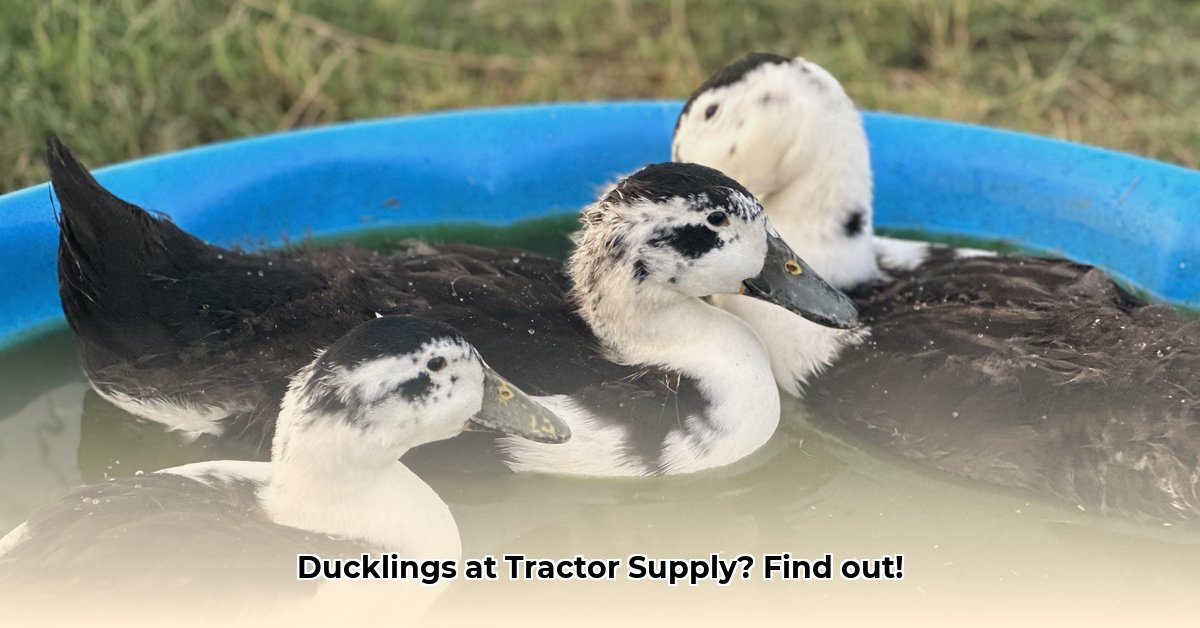
Understanding the Age Inconsistency of Tractor Supply Ducklings
Purchasing ducklings from Tractor Supply can present a challenge: the age of the ducklings isn't always consistent. While Tractor Supply aims for 24-28 days old, the actual age can vary significantly, ranging from a few days old to several weeks. This inconsistency creates hurdles for farmers, impacting duckling survival rates and increasing the workload required. Younger ducklings, for instance, require significantly more intensive care, including constant warmth and frequent feedings, increasing both costs and labor. Older ducklings, while more robust, can still experience stress from transport and handling, affecting their adaptability and overall health. This inconsistency undermines sustainable agricultural practices by introducing unnecessary mortality and resource expenditure. The root causes are multifaceted, including reliance on multiple suppliers and supply chain challenges. For more information on ducklings from Tractor Supply, see this helpful resource.
Decoding Duckling Age: A Step-by-Step Guide
Determining the age of your ducklings is crucial to providing appropriate care. While an exact age is difficult to pinpoint, these steps help you assess their developmental stage:
- Size and Weight: Older ducklings are larger and heavier than younger ones. Comparing the size and weight of several ducklings can provide a relative assessment.
- Feather Development: Examine feathering. Three-day-old ducklings will have minimal down, while three-week-old ducklings will have significantly more feather coverage. The presence of pin feathers (small, emerging adult feathers) indicates a more advanced developmental stage.
- Activity Level: Observe the ducklings' activity. Younger ducklings are generally lethargic, while older ones are more active and mobile. Wobbling and unsteady gait suggest a very young age.
- Inquire with Tractor Supply: Engage with Tractor Supply staff. While age consistency isn't guaranteed, inquire about the approximate age of the current stock and their sourcing practices. This information can offer a rough estimate.
- Veterinary Consultation: If uncertainty remains, consult a veterinarian. They can assess the ducklings' overall health and developmental stage, providing valuable insights and care recommendations.
Caring for Ducklings: Tailoring Care to Age
The care requirements for ducklings vary significantly depending on their age.
Ducklings Under 7 Days Old: These require intensive care, including:
- Consistent Warmth: Maintain a consistently warm environment (using a brooder) to prevent chilling.
- Frequent Feeding: Provide numerous small feedings of a specialized duckling feed throughout the day.
- Close Monitoring: Constantly observe for signs of illness or distress.
- Strict Sanitation: Maintain impeccable cleanliness to minimize the risk of infections.
Ducklings 14-21 Days Old: These require less intensive care than newborns but still need:
- Warmth: Provide a warm, well-ventilated area.
- Regular Feeding: Feed them several times a day with a specialized duckling feed.
- More Space: Increase available space as they grow and become more mobile.
Ducklings 24-28 Days Old and Older: These are relatively robust and require:
- Moderate Temperature: While they still need a warm area, they are less susceptible to chilling.
- Regular Feeding: Fewer feedings per day with an appropriate feed for older ducklings.
- Increased Mobility Space: Plenty of space for movement and activity.
Regardless of age: Implement good biosecurity measures by ensuring adequate space, ventilation, and sanitation to prevent infectious diseases. Consult a veterinarian immediately if you observe any signs of illness, such as lethargy, ruffled feathers, or diarrhea.
Recommendations for Stakeholders
For Tractor Supply:
- Standardize Duckling Age: Implement a system to ensure consistent duckling age across all locations. Clear labeling indicating the estimated age range is crucial and should be prominently displayed.
- Enhance Supply Chain Oversight: Partner with reputable breeders committed to established animal welfare standards. Regular inspections and quality checks are necessary.
- Employee Training: Invest in better training for staff on duckling care, identification of signs of illness, and appropriate handling techniques.
For Farmers:
- Thoroughly Assess Duckling Age: Utilize the provided guidelines to gauge the ducklings' age pre-purchase.
- Provide Age-Appropriate Care: Use the listed care guidelines based on your assessment.
- Prompt Veterinary Care: Seek veterinary assistance the moment you notice signs of illness.
- Maintain Biosecurity: Implement strong biosecurity measures to minimize disease risk.
For Veterinarians and Animal Welfare Organizations:
- Develop Educational Resources: Create accessible resources targeted at farmers, outlining preventative care and disease management strategies.
- Provide Support and Guidance: Offer consultations and support to ensure farmers can raise healthy ducklings effectively.
Conclusion: Ensuring Sustainable Duck Farming Practices
Consistent age labeling, coupled with improved biosecurity measures and responsible care by farmers, are vital for promoting the health and welfare of ducklings. With the improved transparency, efficient processes, and access to relevant resources, farmers can increase the success rate and minimize mortality, supporting sustainable and ethical agricultural practices. Addressing the age inconsistency of ducklings sold at Tractor Supply is a collective responsibility, benefiting both animal welfare and the success of backyard poultry farmers.